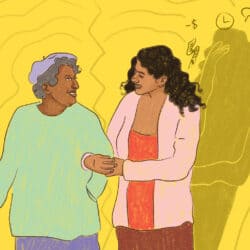Introduction
In April 1984, Canada entered a new era in its treatment of young offenders. The Young Offenders Act became law, replacing the Juvenile Delinquent Act of 1908. The new Act represents a major change, both in values and approach, to the field of juvenile justice. Demonstrating a change in fundamental principles, it moves away from the paternalistic/protectionist view of young offenders to a youth/justice model.
Under the new Act young people are held responsible for illegal behaviour, yet not as responsible as adults since they are perceived as being in a transitional stage from childhood to adulthood. The Act ensures the civil and legal right of young offenders to due process and to fair and equitable treatment within the law. These and other provisions of the Act, e.g., “the right to the least possible interference with freedom consistent with the protection of society” and a uniform age for criminal responsibility of 12 years to 17 years, have great impact on federal and provincial governments as well as the voluntary sector in Canada.
Involvement of Voluntary Organizations: Planning
While many voluntary organizations were involved in the25 years of consultation which led to the new Young Offenders Act, there was no co-ordinated voluntary sector effort. at a national or regional level, to monitor the implementation of the Act, at the time it was made law. Many individual organizations responded to the Act, but in isolation. There was also a lack of”networking” or information sharing as to what was happening in different provinces and some voluntary organizations chose not to monitor the various steps leading to the Act because they considered their primary responsibility to be provision of direct services. Other organizations had little opportunity to act because of the lack of information or opportunity offered by some provinces.
Involvement of Voluntary Organizations: Implementation
Nevertheless, a number of separate activities eventually led to a national collaborative effort by key voluntary organizations in the criminal justice and social service fields which were concerned with youth justice. These included:• A major survey of national voluntary organizations in 1984 which was conducted by the Canadian Council on Social Development and the Canadian Council on Children and Youth. The purpose of the survey was to examine the voluntary sector’s preparedness for the YOA in planning services and carrying out public education and developing local/ provincial co-ordination of activities.
• National meetings on the Act, sponsored by various groups, such as the 1984 meeting of the National Associations Active in Criminal Justice which studied the new Act;
• Increased interest in promoting public education, monitoring activity and consultation between government and the voluntary sector.
The increased opportunity for consultation was welcomed by the voluntary sector as, in the view of many, there were a number of unresolved issues that needed to be examined and brought to the attention of government. These issues included:
• a lack of resources for providing appropriate services which would permit adherence to the new principle of “least possible interference”;
• questionable use of new “mini jail” facilities disguised as “open custody” facilities;
• ambiguity about what to do with offenders under 12 years of age (since they would no longer be included under the Act);
• provincial variations in the extent, type and quality of services available to implement the Act. e.g., there are insufficient alternatives in many provinces;
• unnecessary and prolonged pre-trial detention in some provinces due to the lack of “separate and apart” facilities; and
• lack of specialized programs, i.e., for females or native people.
Development of the National YOA Table
These and other factors led to the development of a National YOA Table, a group of 12 national organizations concerned with youth-related matters (see Appendix). The group is a ‘Table” and not a formal coalition thereby allowing for the independent and autonomous activities of each organization but permitting a constant sharing of responsibility for organizational activities. The activities of the Table, to date, have included information sharing; monitoring of the Act’s implementation: providing support and data to “frontline” workers; and influencing the development of, and changes in, the YOA. The Table also responded to the federal government’s request for two separate consultations regarding a self·evaluation guide for community-based alternative projects and the recent YOA amendments. Mutual support has been given for various projects carried out independently by individual member organizations.
Sample Projects
For example, The Canadian Association for Children and Adults with Learning Disabilities has a project which is designed to increase understanding and awareness among judges of the significant corelation between learning disabilities and criminal behaviour among young people. The John Howard Society of Canada has a YOA co-ordinator who provides information, consultation, and practical assistance with YOA programs and research to John Howard Society agencies. In addition, the Canadian Council on Social Development and the Canadian Council on Children and Youth, with the support of theNational YOA Table, have just completed an update to the 1984 survey of YOA programming in the voluntary sector. This survey generated a computerized database containing descriptive information on programs and public education activities being carried out by the voluntary sector in Canada. A summary of this report was distributed to all voluntary organizations throughout Canada which participated in the study.
Looking Ahead
The voluntary sector in Canada will continue to have an active role in ensuring that the principles of the Act are respected in a consistent and appropriate manner. The scope and focus of that role will depend on the answers to questions such as:
• What kind of partnership for monitoring the Act and responding to its limitations will develop between government and the voluntary sector?
• How can program, research and evaluation initiatives best be co-ordinated to provide maximum benefit to all who bear responsibility for ensuring justice for youth in Canada?
Many challenges face the YOA Table if it is to play an effective role in the continued development and reform of the legislation and implementation of treatment for young offenders.
APPENDIX
National Voluntary Organizations YOA Table
Canadian Council on Social Development Canadian Council on Children and Youth John Howard Society of Canada
National Council of YMCAs
Canadian Association of Elizabeth Fry Societies
Canadian Criminal Justice Association
Salvation Army
Canadian Law Information Council St. Leonard’s Society of Canada Canadian Child Welfare Association
Canadian Association for Children and Adults with Learning Disabilities
Church Council on Justice and Corrections
PHYLLIS DRENNAN-SEARSON
RICHARD WEILER
Canadian Council on Social Development
BRIAN WARD
Canadian Council on Children and Youth


